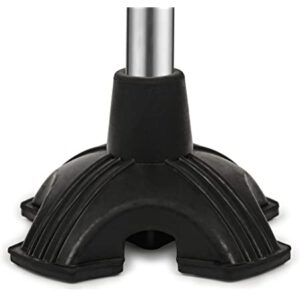Choosing a Standing Cane Tip
When choosing Free Standing Cane you will need to consider several factors. First, you must consider your functional level, which will determine the type of cane you need. Next, you should find a cane with the right grip. This will help you maintain a proper walking posture, protect your joints, and prevent injury from falling.
You may want to choose a cane tip that is non-marking. Many people prefer this option because of the safety it offers. These cane tips come with rubber tips that do not leave any marks on floors. They are also more stable because the rubber prongs stay in contact with the floor for longer. Another benefit is that you will have more control when using them.
Another factor to consider is the type of handle. The type of handle you choose will have a significant impact on the amount of stress that the cane puts on your joints. Some cane handles are designed for style, while others are made to be comfortable. You should choose the one that is comfortable for you. Choosing the right handle for your cane is important because the wrong handle can cause hand pain and numbness.
Once you’ve made a decision on the type of handle, the next step is determining the height. The height should reach the crease of your wrist. If the cane doesn’t reach this height, it may be too short. In this case, you can opt for a taller one.
You can choose from a single, double, or quad-tip. Each option has its pros and cons. The single tip is the traditional style and comes in several colors. Some can even be glow-in-the-dark! You can find single cane tips at most drug stores. You can also choose low-profile versions for a more sleek look. These models usually feature steel washers to prevent excessive wear.
Before purchasing a standing cane, it’s important to check the tip. It should be in good condition and should not be cracked or worn. If you’re using it outdoors, a cracked or worn-out tip will cause a fall or trip hazard. The tip is important because it helps keep the cane secure when you’re walking.
To use a standing cane, you should hold the handle with the dominant leg and hold the cane with the hand opposite your weak leg. Then, step forward with your cane, keeping your elbow close to your body. A quick, equal-length step is good for walking with a standing cane. However, don’t step too far forward, as you’ll increase the risk of falling.
The size of a standing cane is important, as it should be the same height as your wrist. If the cane is too short, you’ll end up hunching over, and your wrists and forearms will be under strain. Choosing a standing cane with the proper size is important if you want to prevent back pain. It’s also important to choose a cane that is comfortable and supports your upper body.
The length of a standing cane is important, too. A cane that’s too short will make it difficult to walk, while a cane that’s too long will cause balance problems. The height of a cane should correspond to the distance from the wrist to the ground. If you’re not sure, consider buying an adjustable model. This way, you can adjust the height of the cane to your height.
You may also want to think about the weight of the cane. A standard cane has a single tip, while a tripod cane has three or four tips. A quad cane is the most stable, but it’s also the heaviest. This can be a problem if you have weak wrists or weak upper body strength. Therefore, you may want to choose a standard cane or an ultra-light model.
In addition to the weight, another factor that should be considered is the tip’s stability. A quad-tip cane provides the greatest stability, but a sling seat cane is a close second. It’s important to choose a standing cane that will help you walk safely.
A self-standing cane tip is an excellent option for many people. Not only does it offer outstanding support, but it’s also easier to store. Many people have experienced the frustration of their cane falling over while walking. Thankfully, there are self-standing cane tips that help the cane stay upright without sacrificing its stability.
